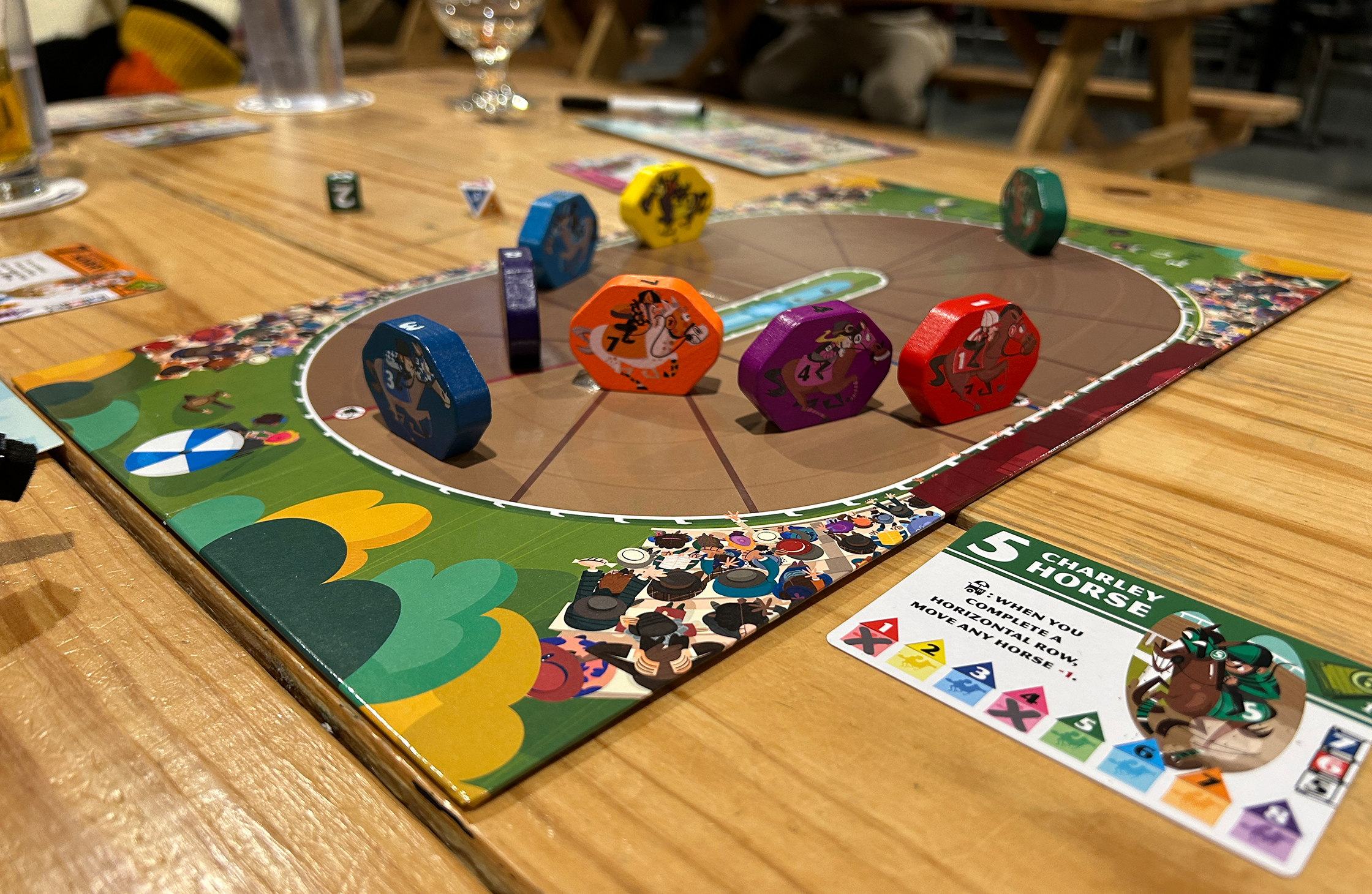I spent a lot of my childhood and adolescence at Southern California race tracks. I could still tell you exactly how to get from the paddock to the grandstands to the infield at a half dozen of them. I was able to understand and translate racing programs by the time I was six, understood how variable odds tracking worked, and pretty much how every kind of bet functioned. The main things I took away from it: horse racing is incredibly boring, and all of that knowledge was pretty useless when it came to picking winners. A day at a track was usually five minutes of something surrounded by an hour and a half of nothing. So, I was happily surprised that Long Shot could finally turn something as dull as horse racing into an entirely enjoyable experience.
Long Shot: the Dice Game is a roll-and-write where players manage a series of bets and other types of actions at a communal race track where eight horses vie for the winner’s circle. Place bets, manipulate horse positions, purchase horses, and try to get them across the finish line before (or at least better than) your opponents.
To start, place the race track board between all players, and place all eight wooden horse markers behind the starting line. Select a set of horse abilities (there are three sets for variability) and place those near the track so that all players can read them. Give each player a laminated player board, a marker, and an asymmetric setup card. Have players fill out their player boards with concessions values checked off and some free bets (according to their setup cards). Choose the first player, give them the dice, and start playing.
The dice the active player rolls are a 6-sided die (d6) and an 8-sided die (d8). The d8 determines which horse is the primary horse, and the d6 determines how far along the track the primary horse moves. Once a roll is made, advance the primary horse the number of spaces the d6 shows and then take a look at the horse ability cards near the track. Each of these has a list of all of the horses and an ‘x’ on some of them. For each horse with an ‘x’ over it, move the corresponding horse forward on the track one space. Once the horses have moved, each player takes an action.
A player can do one of five things as an action. They can place a bet on the primary horse as long as that horse hasn’t passed the no-bet line on the track. They can cross off a concession value in the 4x4 grid on their board and, if doing so completes a row or column, take a one-time bonus. They can purchase the primary horse if it’s available, granting access to its special ability and potentially earning a cash bonus if the horse winds up in the top-three. They can check the primary horse’s helmet icon off, allowing them to ignore the no-bet line on the track and bet on the horse in subsequent turns regardless of its position. Finally, they can check off the jersey icon for the primary horse and add an ‘x’ to the primary horse’s card, over any horse of their choice, thus increasing the number of horses that the primary horse will advance if its number is rolled in subsequent turns.
Unless three horses have passed the finish line, pass the dice, let the next player roll them, and repeat the process until the winner’s circle is filled. Total up cash from horses owned, bonuses, and bets placed. Whoever has the most money wins.
Component-wise, Long Shot is fantastic. Boards are solid, laminated player-boards make the game easy to clean, and cards are coated in heavy plastic so they’ll hold-up being written on and erased over several playthroughs. For once, the game box isn’t larger than it needs to be, and has a magnetic clasp instead of a box-lid to close it up. The illustrations are clear, easy to read at a distance, and the horses are super derpy.
I have a bunch of roll-and-writes, but Long Shot stands out, because unlike so many other games in that category, there’s a lot of player interaction. Too many roll-and-writes are essentially solo games played with multiple people. While Long Shot can be played solo, the real heart of the game comes when you get a group of folks together — backstabbing each other in order to get their horses just a few spaces further.
The fact that it plays up to eight and there isn’t ever significant downtime makes it a really easy game to take over to family gatherings. While it isn’t an incredibly deep game, and there isn’t a whole lot of room for exploration and strategy, I can definitely see this one getting pulled out as a warm-up on a lot of game nights.
Designed by: Chris Handy
Player Count: 1–8
Playtime: 30 minutes
Time to Learn: 5 minutes
Complexity: 1.5
Replayability: 4/5
MSRP: $30
Written by Brendan Quinn, President of Tri-City Area Gaming. We’re out in the world again! Come play games with us at any of our regular monthly events.
All the links for Tri-City Area Gaming: tcag.carrd.co


